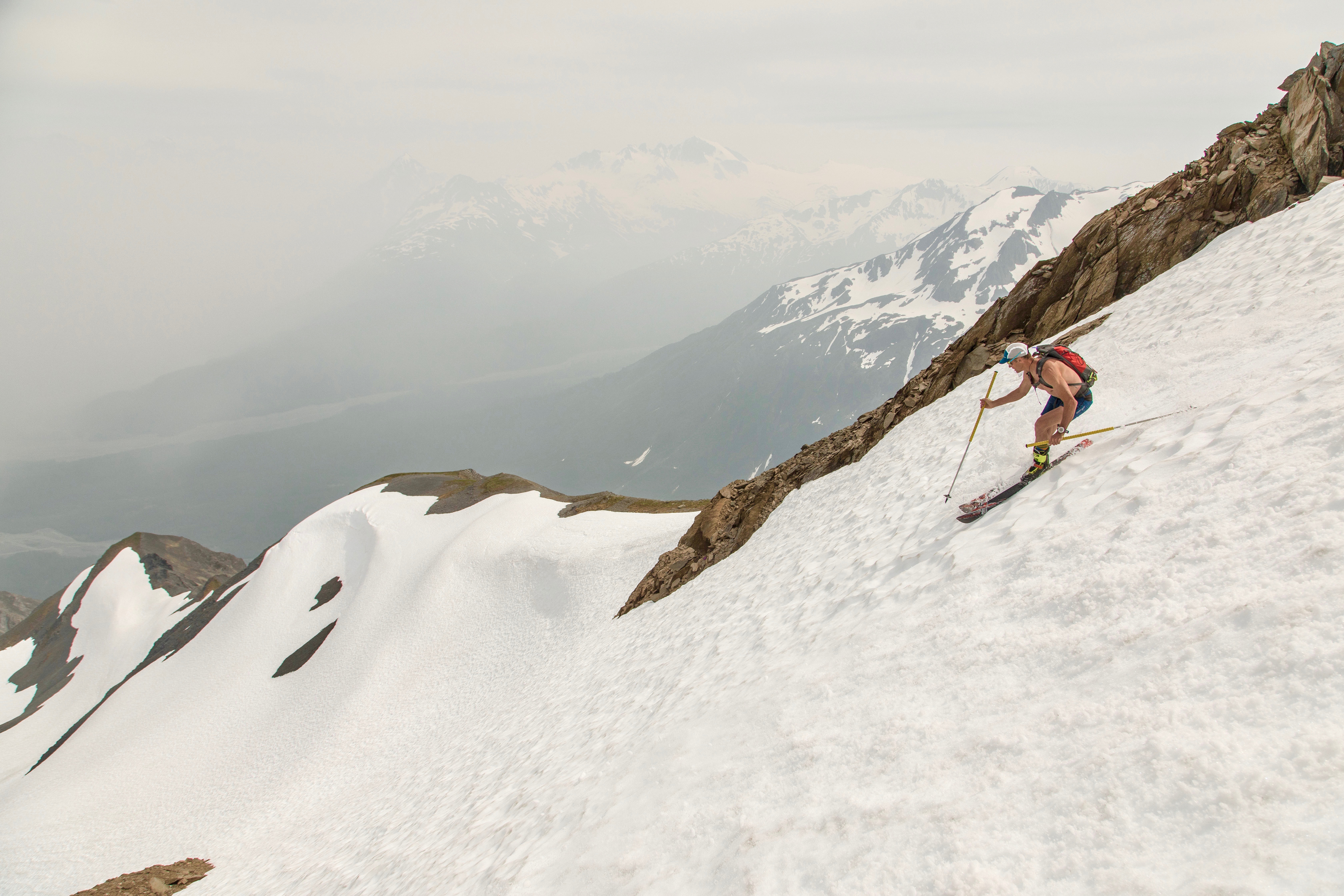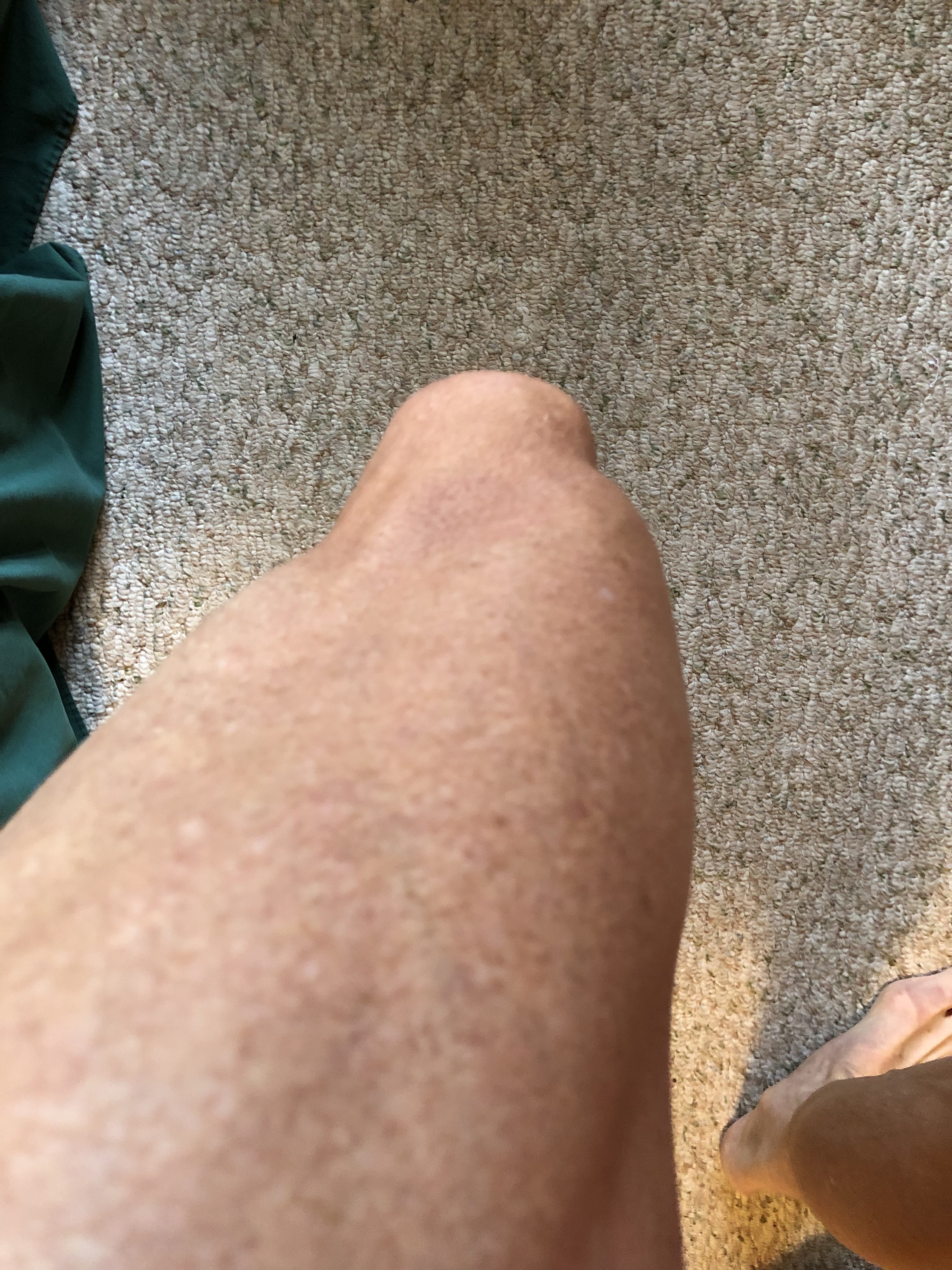Blown - Life after my ACL rupture - 6
 Tuesday, September 24, 2019 at 02:13AM
Tuesday, September 24, 2019 at 02:13AM  This post should conclude the Blown series of posts over the last 17 months. If you’ve been reading all along then you know my experience with my ACL reconstruction of my left knee has been bumpy, at best. The purpose of this final post is to report on my ultimate outcome as well as some thoughts for others facing a similar prospect now that I have hindsight in my favor.
This post should conclude the Blown series of posts over the last 17 months. If you’ve been reading all along then you know my experience with my ACL reconstruction of my left knee has been bumpy, at best. The purpose of this final post is to report on my ultimate outcome as well as some thoughts for others facing a similar prospect now that I have hindsight in my favor.
 Wallowing in the early summer smoke above the Harding Icefield, AKFor those following me on Instagram, you already know that I’ve been back skiing for the majority of the winter. I’d say that for the past 3 months, at least, I’m skiing at about 95%, with the only down turn in performance being a self-imposed speed reduction. Otherwise, I’m charging nearly all terrain in all conditions. For most of the season, I used a Donjoy ACL brace for all skiing. Sometime in late April I forgot to bring it on an after work corn session. I went anyway and felt fine. I decided that with the more predictable nature of spring skiing, I could live without it. I’ve had no issues since. There was a mental liberation of sorts once I committed to skiing brace-free.
Wallowing in the early summer smoke above the Harding Icefield, AKFor those following me on Instagram, you already know that I’ve been back skiing for the majority of the winter. I’d say that for the past 3 months, at least, I’m skiing at about 95%, with the only down turn in performance being a self-imposed speed reduction. Otherwise, I’m charging nearly all terrain in all conditions. For most of the season, I used a Donjoy ACL brace for all skiing. Sometime in late April I forgot to bring it on an after work corn session. I went anyway and felt fine. I decided that with the more predictable nature of spring skiing, I could live without it. I’ve had no issues since. There was a mental liberation of sorts once I committed to skiing brace-free.
I stuck to my rehab program, focusing on regaining the lost strength in my left leg and trying to correct the obvious atrophy of my quad. Something not quite right here.I clearly suffered some sort of neurologic injury to one of the branches of my femoral nerve, perhaps during the administration of my perioperative nerve block. You can see in the pictures that something very odd was going on. Over the months of training, most of it has resolved although one can still see something odd in my VMO. Although I have not done a formal assessment, I’m certain that there is still measurable weakness side to side.
Something not quite right here.I clearly suffered some sort of neurologic injury to one of the branches of my femoral nerve, perhaps during the administration of my perioperative nerve block. You can see in the pictures that something very odd was going on. Over the months of training, most of it has resolved although one can still see something odd in my VMO. Although I have not done a formal assessment, I’m certain that there is still measurable weakness side to side.  Better nowOn the other hand, I don’t really notice this when running, hiking, cycling and skiing.
Better nowOn the other hand, I don’t really notice this when running, hiking, cycling and skiing.
With the dry weather this summer in Alaska, I went on a cycling binge after skiing ended in July. I decided to drop the weight training for a period just to have the mental break. Now as September gets rolling, I’m back in the weight room gearing up for the demands of my first turns, hopefully in a few short weeks. The wetness has returned to South Central AK so the snow will fall with the temperatures.
Hindsight
Looking back on my experience with ACL reconstruction, I’d say my biggest challenge was dealing with a necessary loss of physical conditioning that comes with any injury and surgery. I ended up with about a 5 week layoff between injury and surgery. It was a struggle emotionally to lose something I’d spent my life maintaining. In the grand scheme, this “loss” was nothing compared to people who suffer far more grievous injuries but was nonetheless significant for me. Looking back, the advice I’d give to myself is to try and relax more and simply let it go, knowing that it’s almost assuredly recoverable. This is even more important in the early rehab phase. I was in such a hurry to get riding and get stronger that I pushed hard even when my knee wasn’t really ready for it. Fighting through pain and stiffness is certainly part of the deal but I think doing so more slowly than I did makes things easier in the long run. For sure, once my joint was “quiet” after a few months, gains were easier.
Of course, some peoples’ joints quiet down sooner than others. I’m still convinced that my reaction to my cadaver graft was more severe than others. I remained swollen and lacked full extension for months. I don’t think this was due solely to my enthusiasm but rather some hard-to-define technical issue from the operation itself. I don’t think I’ll ever know.
I have another friend who blew his knee around the same time as I did. I wrote him a note asking him if he was charging through his rehab, riding and lifting so he could get back to guiding. Nonchalantly he mentioned that he hadn’t done much of anything for 3 months. My jaw dropped. And yet when he finally got to it, he eased back into a full summer of guiding in Chamonix and the Alps without a hiccup. Maybe there’s a lesson there for all of us going forward.
Closing Thoughts
What would I do differently if I had to do it all over again? First of all, I think having a bone-to-bone interface in the tunnels of the femur and/or tibia improves healing time and the early strength of the graft fixation. Asking tendon to heal to bone is a bigger ask, for sure. That said, tens of thousands of hamstring grafts have been used successfully. But if you ask a bunch of surgeons, many would admit that the Gold Standard of grafts is an autograft made from patella bone-tendon-bone. In a patient younger than 35 years old, I’d be tempted to recommend nothing else. But if I was pushed, I’d go with what I wished I had gone with in the first place and that is a quad tendon autograft. Check out this for a full discussion. I wish I had simply searched out a surgeon with a fair number of these under his/her belt and traveled there for the surgery. My own tissue from a lower morbidity donor site with a bone plug on one end seems like the best compromise of all the options. On the other hand, I had an email discussion recently with a surgeon with a fair amount of experience with the quad tendon autograft and he feels that he no longer needs the bone plug end to get a good result. The shorter graft is both thick and stiff.
Following surgery, I’d probably do nothing but range of motion work and nearly resistance free stationary cycling for a month. I’d want a quiet knee with little or no swelling before adding any sort of challenge in rehab. Hopefully, I won’t have to heed my own advice again any time soon. Thanks for coming along. I hope this helps some of you during your own recovery. Cheers.
 Brian |
Brian |  11 Comments |
11 Comments |  ACL reconstruction,
ACL reconstruction,  back country skiing in
back country skiing in  General
General 





Reader Comments (11)
I have been following your saga after a mutual friend mentioned it to me... I had an acl repair about 2 years ago with a hamstring autograft. I had complications in the tibia incision site and had to have two additional proceedures to clean that out and they eventually removed the anchor for fear of infection.
Because of the two extra surgeries, I took it real slow to come back, and it was a solid 1y before I really started to trust it again. I think that has been the key to success... starting back on it nice and slow.
Best of luck, and glad to see you back at it...
Hey Greg,
Thanks for sharing. Yeah, there are certainly lots of different wrinkles in the recovery that a small percentage of us can experience. I'm glad any infection you may have had related to the hardware in your tibial tunnel didn't go deep. This can spell disaster for your joint in the long run. Hopefully, you had full incorporation of your graft by the time they removed the fixation. So sketchy, eh? But if you're back at it then it sounds like you probably did. Most excellent. What a drag losing those couple of seasons waiting to get out from under it. As I face my first full season back, I dread the thought of another injury. Train hard, slow down. That's my mantra. Cheers.
Really valuable to share these insights. Any sage advice to a non-injured person wanting to prioratize ongoing prehab and resistance training to help buffer against knee injuries? What would you tell your 40 year old self?
Aaron,
Of course. You know me...always good for an opinion.
First of all, don't kid yourself too much. The strongest skiers in the world hurt themselves. However, we know from the soccer literature that certain types of training can prevent ACL injuries in certain groups of kids. It stands to reason, then, that all of us can get some degree of "protection" by preparing ahead of time.
First off, strength is king. Period. If you do only one thing, get stronger. That means lifting weights in some fashion. Mountain biking and hiking are not going to do it unless you're a complete couch potato. Squats, deads, lunges, leg presses all will fill the bill. Younger guys can get away with loading the spine more so two-legged heavy movements will work. But for us older guys, I think prioritizing single-leg movements transfers better, has a higher degree of coordination and allows for less load on the spine. All good things. I like weighted lunges and step ups as the foundation here. Lots of other related stuff that I'll not bore you with here. And don't forget the hammies. Nordics and bridge variations will get it done.
After getting stronger, rate of contraction is the other thing to improve. This will be done by sprinting or doing one and two legged plyometric jumping drills. Lots of options here. Just get explosive. If "turning on" the system will save your knee, doing so quickly is the key. Plyos should help with that.
Starting this stuff late summer and having 3 months under your belt by the time you step into your bindings is probably the best approach, IMO. Cheers.
Thanks Brian. Good to hear confirmation for what I have been working towards. Last 5 years have been a learning progression towards proper 'training' vs random exercise (heavy Uphill Athlete influence). This is the first year that I did a proper 8 week transition period with body weight through weighted progressions of hip/knee/glute focused general strength leading into my base period which includes max strength and muscular endurance gym workouts. Feels amazing and each year I have been able to progress faster and go heavier. Here's to 30 more years of mobility and capacity. Thanks for documenting and sharing.
Brian: Your ACL series has been extremely informative. So sorry for your complications, but very glad to hear things have been generally improving for you over the past year. I'm a 55 yo with similar enthusiasm for the same mountain activities. It's such a big deal to have significant injuries at this age - - your comments on strength work as a preventative are so key. Thanks again for all the insight you communicate via your blog!
Patrick,
Thanks for reading and speaking up. My whole intention for writing the series was simply to pull the veil from the mystery of this injury and all that it entails. I glad you found it informative. Onward.
Remember this. That cadaver part is inert tissue and will never have any blood supply. it is a mechanical fix. I play competitive lacrosse and am over 50. I blew out the knee. Had the graft. Played with a brace for years. One day decided I was so strong i didnt need the brace. Blew it out in the first 5 minutes of a game. There is no good redo on a graft. Did total knee replacement and worked it hard in rehab for a year. Better than ever,
Blown ACL's do not get strong enough to do big time stuff without a brace. At some point they wear out too
I appreciate your input, Bill. We each have our anecdotes that are at least meaningful to us. But I've worked in orthopedics for over 25 years and have been apart of countless knee reconstructions and more recently, thousands of knee replacements. Your observation about the cadaver graft being inert is true. However, it becomes a scaffolding for our own collagen to form. Ultimately, many studies have demonstrated that after many months, there is no cadaver DNA left in the new ACL, meaning it has been replaced. In this way, it can "live" again.
As for returning to high level sport, tens of thousands of athletes have done so and without a brace. Certainly, one could make an argument that the injured leg is never 100% but performance can still be quite high.
Lastly, your final move to a total knee replacement is completely predictable, no matter how good the outcome of a reconstruction. The original injury exacts a severe toll on the joint and the chicken come home to roost eventually, sometimes decades later. Glad you're back at it.
Brian, have you seen Stoko braces? https://stokodesign.com/products/mens-k1-tight
I just came across them and they look interesting - wondering if you have any experience.
Hey Aaron,
I'm not sure what to say. I have NOT seen them before. Looks kinda crazy but very interesting at the same time. The price is startling, too.